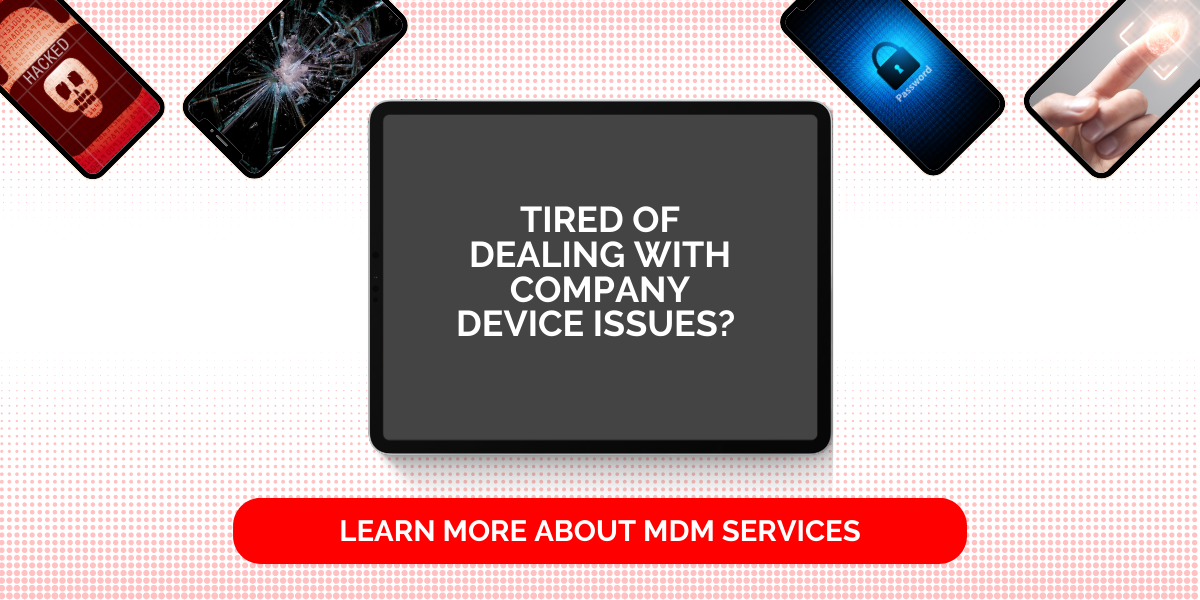Does this sound familiar? You have 30 devices your employees use… and you get requests all the time about configuration issues, people are adding their own apps onto the devices that allow them to chew up your data plan as well as their own productivity, and some devices even get lost or stolen, which leaves your company’s data out in the wind.
In today’s fast-paced digital landscape, where mobile devices have become integral to both personal and professional lives, businesses face numerous challenges in managing their devices effectively and securing sensitive data.
If these concerns resonate with you, it’s probably time to discuss Mobile Device Management (MDM).
MDM is a powerful tool that enables organizations to streamline device management, enhance network security, and help businesses enhance productivity, communication, and customer experiences.
By leveraging MDM, businesses can centrally manage and secure company devices, enforce usage policies, remotely wipe data if needed, and ensure consistent configuration and app management.
In this article, we will explore the ins and outs of mobile device management, uncovering how it works and how it can revolutionize your organization’s device management strategies.

What Specifically is Mobile Device Management (MDM)?
Before diving into the details, let’s start with a brief overview of MDM.
Mobile Device Management refers to a comprehensive set of tools, technologies, and security policies designed for securing and managing mobile devices within an organization. It encompasses a wide range of functionalities, including device configuration, application management, security enforcement, remote device management, and more.
Mobile device management provides IT administrators with centralized control and visibility over mobile devices, ensuring properly managed devices that are updated and secured. This can be done without physically accessing the devices or relying on user assistance.
What are the Key Components of MDM?
To understand how mobile device management works, it’s essential to grasp its key components. Policies, profiles, and device enrollment form the foundation of MDM.
Policies define rules and restrictions that govern device usage, security protocols, and compliance requirements.
Profiles, on the other hand, allow administrators to configure device settings, deploy applications, and enforce security measures.
Device enrollment involves registering devices into the MDM operating system, granting administrators the ability to manage and control them remotely.

What are the Main Benefits of MDM?
1. Device Configuration Made Simple
One of the greatest perks of MDM is its knack for simplifying device configuration. Say goodbye to the days of tediously setting up devices one by one. With mobile device management, administrators can wave their magic wands and automate the setup process, ensuring that devices come pre-loaded with all the essential applications, settings, and security protocols.
Let’s consider a real-life scenario. Imagine a dynamic sales team hustling in a pharmaceutical company. Thanks to MDM, their company-issued iPads or even their personal devices can be preloaded with customer relationship management (CRM) apps, email clients, and VPN configurations, all set up and ready to roll. With just a few taps, they’re armed with the tools they need to hit the ground running and forge connections with clients, boosting their sales efforts.
By effortlessly streamlining device configuration, MDM saves valuable time and effort for both administrators and end-users alike. It ensures that devices are swiftly and consistently set up to meet the specific needs of each business, empowering teams to focus on what they do best—closing deals, delivering exceptional customer experiences, and driving success.
How Device Personalization Works
One common question that arises is whether MDM service providers offer personalized device configurations for their clients. But MDM solutions like Macserv go above and beyond to tailor device profiles to meet the unique needs of organizations.
Let’s say a marketing agency implements a Bring Your Own Device (BYOD) policy to allow employees to use their personal smartphones for work-related tasks. One of the challenges they face is ensuring the security of sensitive client data on these personal devices.
Read more about BYOD and MDM solutions involving HIPAA regulations for businesses in medical industries.
With an MDM solution, your business can confidently navigate the challenges of personal device use. By implementing strict security measures like password policies and data encryption on employee-owned devices, you safeguard sensitive information from prying eyes. And if a device is lost or stolen, remote wiping ensures that confidential data remains protected.
But it doesn’t stop there. The seamless setup process of Macserv’s MDM automatically restores all profiles and policies, tailored to the unique workflows of each department, and increasing user satisfaction.
For example, you can create custom profiles for each department, providing your drivers with specialized apps, dispatchers equipped with communication and tracking tools, and administrative staff with productivity apps for managing schedules and logistics. This personalized approach streamlines workflows and enhances efficiency within your organization.
The result? Optimized device deployment, reduced manual configuration headaches, and devices that empower employees to excel in their roles.
2. Robust Security Measures
With MDM, you can secure your business with a range of robust measures to safeguard your valuable information and stop unauthorized access. First, you can enforce stringent password policies, encrypt data, and remotely wipe devices in the unfortunate event of loss or theft. These measures ensure that your sensitive data remains secure and confidential, even in challenging situations.
Moreover, an MDM offers a seamless process for corporate-owned devices. After a remote wipe, the devices automatically restore all profiles and policies during setup. This means you save precious time and effort while maintaining a secure environment for your business operations.
But an MDM doesn’t just stop at security—it goes the extra mile to protect your business data comprehensively. Mobile device management services include business data backup and disaster recovery solutions. Rest assured that your important information is not only safeguarded but also easily recoverable in the face of unforeseen events. This peace of mind allows you to focus on your core business activities, knowing that your valuable data is protected against any potential threats.

In addition to data security, MDM empowers you to establish strict access controls. This ensures that only authorized individuals can access your company resources, preventing any unauthorized use or breaches. This level of control is particularly crucial in industries such as healthcare, finance, and government organizations, where sensitive data is handled with utmost care.
Privacy is of course a top concern when implementing an MDM solution. That’s why it’s vital to address privacy concerns throughout the entire process. Forbes’ article titled “How to Address Privacy Concerns When Building a Mobile Device Management Solution” is a helpful resource describing how MDM effectively protects a business’s data privacy.
By implementing privacy considerations from the start, you can ensure that your MDM implementation aligns with privacy regulations and best practices, giving you and your customers peace of mind.
3. Remote Monitoring and Control for Mobile Devices
MDM enables IT administrators to monitor and manage corporate devices and personal mobile devices remotely, regardless of their physical location. Administrators can track devices´ locations, monitor battery levels, and troubleshoot issues without the need for physical access.
For example, if a field service technician encounters a software glitch on their personal mobile device, an IT administrator can remotely troubleshoot the problem for them, reducing downtime and increasing productivity to get your service professional and business back on the road.

4. Application Management and Distribution
Managing multiple mobile devices or even applications across a fleet of devices can be a daunting task. MDM simplifies this process by allowing administrators to centrally control application distribution and updates.
They can push essential business apps to personal devices, ensuring employees have the necessary tools readily available. Additionally, administrators can blacklist or whitelist specific apps, ensuring compliance and preventing the installation of unauthorized or potentially harmful applications.
5. Compliance and Reporting
Compliance with industry regulations and internal policies is crucial for organizations. MDM facilitates compliance by providing comprehensive reporting and auditing capabilities.
Administrators can generate detailed reports on device usage, data security status, and compliance adherence. This information helps organizations stay compliant with HIPAA (Health Insurance Portability and Accountability Act) and GDPR (General Data Protection Regulation), providing peace of mind and mitigating potential risks.
Future Trends and Innovations
MDM continues to evolve and adapt to the changing technology landscape. Integrating MDM with emerging technologies such as the Internet of Things (IoT) and artificial intelligence opens up new possibilities.
For example, MDM can extend its management capabilities to IoT devices, enabling centralized control and data security software for a diverse range of endpoints. AI-powered analytics can provide valuable insights into device performance, usage patterns, and potential data security threats, allowing proactive management and optimization.
In today’s rapidly evolving technology landscape, proactive device management is essential for maintaining security and performance. Macserv offers AI-powered analytics, delivering valuable insights into device performance, usage patterns, and potential data security threats.
Take a proactive approach to device management and optimization by partnering with Macserv. Learn more about MDM here.


